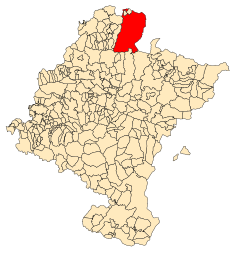Baztan, Navarre
| Baztan | |||
|---|---|---|---|
| Comarca | |||
 |
|||
|
|||
 |
|||
| Coordinates: 43°07′N 1°17′E / 43.12°N 1.28°ECoordinates: 43°07′N 1°17′E / 43.12°N 1.28°E | |||
| Country |
|
||
| Autonomous community | Navarre | ||
| Province | Navarre | ||
| Capital | Elizondo | ||
| Government | |||
| Area | |||
| • Total | 373.55 km2 (144.23 sq mi) | ||
| Population (2009) | |||
| • Total | 8,127 | ||
| • Density | 22/km2 (56/sq mi) | ||
| Time zone | CET (UTC+1) | ||
| • Summer (DST) | CEST (UTC+2) | ||
| Postal code | 31700 | ||
| Dialing code | 948 | ||
| Website | http://www.baztan.es/ | ||
Baztan is a municipality from the Chartered Community of Navarre, northern Spain. It is located 58 km (36 mi) from Pamplona, the capital of Navarre. It is the largest municipality in Navarre, with around 376.8 km2 and just over 8,000 inhabitants.
The capital of the valley is Elizondo, and includes other 14 villages, as follows:
The territory of the Baztan valley extends over an area of 377 square km of which much is common land jointly owned by the residents of the Baztan valley and primarily used as grazing ground for flocks of sheep and herds of semi-wild horses. The Baztan Valley borders with the French Basque regions of Lapurdi and Lower Navarre which is accessed by the Izpegi Pass to the east of the valley and Dantxarinea to the north. This vicinity to France and its ties with its Basque neighbours has greatly characterised the history of the Baztan people over the past centuries. In 2013 there were 7974 people living in the Baztan Valley with 3489 people living in the capital of Elizondo. The remaining population are spread out between the other 14 mountain villages (see above).
The Baztan Valley is scarcely populated with small-scale pastoral farming making use of the verdant pastures along the banks of the Baztan river. Orchards of apple, quince, cherry, pear and peach trees are common and more recently kiwis have been planted in the area. The mountain slopes are densely covered with oak, chestnut, walnut, beech, and ash. The odd palm tree can sometimes be found in the grounds of the larger manor houses in the area and often belies family links to the Americas where many Baztan people have emigrated since the 16th century.
Around 1025 the duke of Gascony, Sancho VI William (son of Duke William II Sánchez and Urraca Garcés of Navarre, widow of Count Fernán González of Castile), gave part of the duchy to King Sancho III of Navarre. Sancho created a lordship for Ximen I Ochoaniz consisting of the Baztan Valley. His son Garcia Xemeniz became a viscount between 1055 and 1065, and his grandson Ximen I Garciez (lord of Lizarra and the Salazar Valley from 1051 to 1080) donated land to the monastery of Leire in exchange for a pardon for assassinating his nephew.
...
Wikipedia


